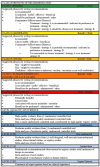Managing Hypercholesterolemia in Adults Older Than 75 years Without a History of Atherosclerotic Cardiovascular Disease: An Expert Clinical Consensus From the National Lipid Association and the American Geriatrics Society
- PMID: 40207842
- PMCID: PMC12205287
- DOI: 10.1111/jgs.19398
Managing Hypercholesterolemia in Adults Older Than 75 years Without a History of Atherosclerotic Cardiovascular Disease: An Expert Clinical Consensus From the National Lipid Association and the American Geriatrics Society
Abstract
The risk of atherosclerotic cardiovascular disease increases with advancing age. Elevated LDL-cholesterol and non-HDL-cholesterol levels remain predictive of incident atherosclerotic cardiovascular events among individuals older than 75 years. Risk prediction among older individuals is less certain because most current risk calculators lack specificity in those older than 75 years and do not adjust for co-morbidities, functional status, frailty, and cognition which significantly impact prognosis in this age group. Data on the benefits and risks of lowering LDL-cholesterol with statins in older patients without atherosclerotic cardiovascular disease are also limited since most primary prevention trials have included mostly younger patients. Available data suggest that statin therapy in older primary prevention patients may reduce atherosclerotic cardiovascular events and that benefits from lipid-lowering with statins outweigh potential risks such as statin-associated muscle symptoms and incident Type 2 diabetes mellitus. While some evidence suggests the possibility that statins may be associated with incident cognitive impairment in older adults, a preponderance of literature indicates neutral or even protective statin-related cognitive effects. Shared decision-making which is recommended for all patients when considering statin therapy is particularly important in older patients. Randomized clinical trial data evaluating the use of non-statin lipid-lowering therapy in older patients are sparse. Deprescribing of lipid-lowering agents may be appropriate for select patients older than 75 years with life-limiting diseases. Finally, a patient-centered approach should be taken when considering primary prevention strategies for older adults.
Keywords: hypercholesterolemia; older adult; primary prevention.
© 2025 The Author(s). Published by Elsevier Inc on behalf of National Lipid Association and John Wiley and Sons Inc. on behalf of American Geriatrics Society.
Figures



Similar articles
-
Managing hypercholesterolemia in adults older than 75 years without a history of atherosclerotic cardiovascular disease: An Expert Clinical Consensus from the National Lipid Association and the American Geriatrics Society.J Clin Lipidol. 2025 Mar-Apr;19(2):215-237. doi: 10.1016/j.jacl.2024.09.005. Epub 2025 Apr 10. J Clin Lipidol. 2025. PMID: 40250966
-
A systematic review and economic evaluation of statins for the prevention of coronary events.Health Technol Assess. 2007 Apr;11(14):1-160, iii-iv. doi: 10.3310/hta11140. Health Technol Assess. 2007. PMID: 17408535
-
Statins for children with familial hypercholesterolemia.Cochrane Database Syst Rev. 2017 Jul 7;7(7):CD006401. doi: 10.1002/14651858.CD006401.pub4. Cochrane Database Syst Rev. 2017. Update in: Cochrane Database Syst Rev. 2019 Nov 7;2019(11). doi: 10.1002/14651858.CD006401.pub5. PMID: 28685504 Free PMC article. Updated.
-
Cost-effectiveness of using prognostic information to select women with breast cancer for adjuvant systemic therapy.Health Technol Assess. 2006 Sep;10(34):iii-iv, ix-xi, 1-204. doi: 10.3310/hta10340. Health Technol Assess. 2006. PMID: 16959170
-
Behavioral interventions to reduce risk for sexual transmission of HIV among men who have sex with men.Cochrane Database Syst Rev. 2008 Jul 16;(3):CD001230. doi: 10.1002/14651858.CD001230.pub2. Cochrane Database Syst Rev. 2008. PMID: 18646068
References
-
- Levine G. N., O'Gara P. T., Beckman J. A., et al., “Recent innovations, modifications, and evolution of ACC/AHA clinical practice guidelines: an update for our constituencies: a report of the American College of Cardiology/American Heart Association Task Force on Clinical Practice Guidelines,” J Am Coll Cardiol 73 (2019): 1990–1998. - PubMed
-
- Jacobs A. K., Kushner F. G., Ettinger S. M., et al., “ACCF/AHA clinical practice guideline methodology summit report: a report of the American College of Cardiology Foundation/American Heart Association Task Force on Practice Guidelines,” Circulation 127 (2013): 268–310. - PubMed
-
- Phan B. A. and Bittner V., “Lipid‐lowering therapy in patients 75 years and older: clinical priority or superfluous therapy?,” Prog Cardiovasc Dis 57 (2014): 187–196. - PubMed
-
- Schatz I. J., Masaki K., Yano K., Chen R., Rodriguez B. L., and Curb J. D., “Cholesterol and all‐cause mortality in elderly people from the Honolulu Heart Program: a cohort study,” Lancet 358 (2001): 351–355. - PubMed
-
- Corti M. C., Guralnik J. M., Salive M. E., et al., “Clarifying the direct relation between total cholesterol levels and death from coronary heart disease in older persons,” Ann Intern Med 126 (1997): 753–760. - PubMed
MeSH terms
Substances
LinkOut - more resources
Full Text Sources
Medical

